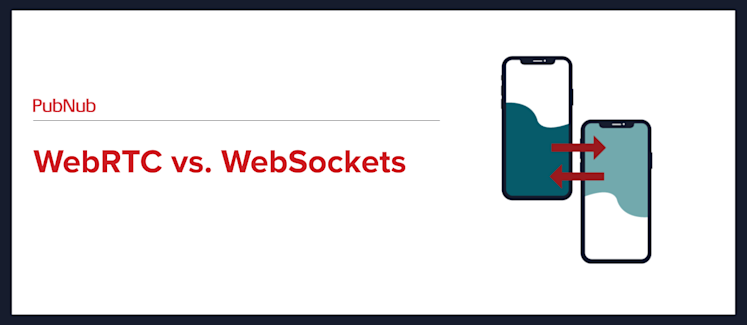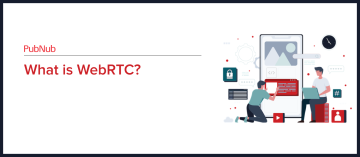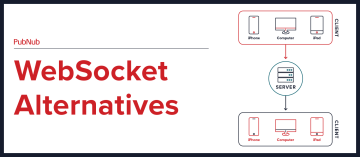
In real-time communication and web development, two popular technologies have gained significant attention: WebRTC and WebSockets. As developers seeking to build high-performance, scalable, and low-latency applications, it is crucial to understand the differences between these technologies, their use cases, and their advantages/disadvantages.
In this post, we will dive into WebRTC and WebSockets, comparing and contrasting the two communication protocols, and guide you through making the right choice for your application needs.
WebRTC vs. WebSockets: Understanding the Technologies
What is WebRTC?
Web Real-Time Communication (WebRTC) is an open-source project that enables real-time, peer-to-peer communication between modern browsers and mobile devices. WebRTC's primary use cases include video calls, video conferencing, and other video communications. Chrome, Firefox, and other modern browsers natively support WebRTC, eliminating the need for plugins.
WebRTC offers a set of APIs and network protocols that enable seamless video chat and peer communication capabilities. For instance, RTCPeerConnection establishes and manages peer connections, and MediaStream captures audio and video streams from the user's devices.
To get started with WebRTC, you can explore their official documentation.
WebRTC Alternatives
While WebRTC is a popular choice for video communications, some alternatives include:
Flash-based solutions (now mostly deprecated)
Proprietary video communication solutions (e.g., Zoom SDK)
What is WebSocket?
WebSocket is a communication protocol that enables bidirectional communication between a web browser and a web server over a long-lived, full-duplex TCP connection. WebSocket is well-suited for web applications that require real-time communication, such as chat apps, multiplayer games, and live updates.
WebSocket API allows developers to send messages as text strings or binary data (e.g., Blob or ArrayBuffer objects) between the browser and server. WebSocket's design encourages low-latency communication, making it suitable for applications needing constant updates and interaction.
Check out WebSocket's official documentation to learn more.
WebSocket Alternatives
Some WebSocket alternatives to consider are:
Comet (combination of long polling and streaming)
Advantages and Disadvantages of WebRTC vs. WebSockets
Advantages of WebRTC
Peer-to-peer communication: WebRTC enables direct communication between participants, which leads to reduced latency and bandwidth usage for video communications, making it suitable for video calls and conferencing applications.
Browser support: WebRTC is supported by modern browsers like Chrome and Firefox, making it easier for developers to integrate it into web apps without requiring users to install plugins.
Security: WebRTC uses STUN, TURN, and SRTP to ensure secure peer communication, even when traversing NAT or firewalls.
Media handling: WebRTC's built-in support for handling media streams (audio and video) makes it developer-friendly for creating rich multimedia applications.
Disadvantages of WebRTC
Complexity: Setting up and managing signaling servers and protocols for WebRTC can be complex, especially when considering network traversal, data channels, and media management.
Scalability: WebRTC's peer-to-peer nature can lead to scalability issues in large-scale applications involving many concurrent users. In such cases, additional infrastructure may be required to maintain optimal performance.
Advantages of WebSocket
Bidirectional communication: WebSocket enables two-way communication between the browser and server, making it ideal for real-time applications like chat apps and multiplayer games.
Low latency: WebSocket's full-duplex connection allows data to be sent and received simultaneously, reducing latency in applications that require constant updates and interactions.
Wide adoption: WebSocket is widely adopted and supported by most modern browsers, offering high compatibility across platforms.
Versatility: WebSocket is not limited to specific use cases like WebRTC and can be applied to various applications.
Disadvantages of WebSocket
Lesser media handling capabilities: Unlike WebRTC, WebSocket isn't explicitly designed for audio and video streams, so developers may need to implement additional components and libraries to handle the media streams.
Server dependency: WebSocket relies on a persistent connection to a server, which could introduce a potential point of failure and may have higher resource requirements than WebRTC's peer-to-peer communication.
Using WebRTC and WebSockets: What Can You Do?
What You Can Do with WebRTC
WebRTC is specifically designed to handle real-time communication involving audio and video streams and data channels. With WebRTC, developers can create a variety of applications, such as:
Video chat and conferencing: Create video chat applications that allow users to make instant, low-latency audio and video calls or hold video conferences with multiple participants.
Live streaming: Build live streaming platforms for video broadcasts, webinars, and online events where presenters can share audio, video, and real-time data feeds with viewers.
Interactive online learning: Develop web-based platforms for distance learning where students can engage with instructors and peers through video, audio, and chat functionalities.
Remote collaboration: Enable remote teams to collaborate efficiently through screen sharing, whiteboarding, and file-sharing tools in realtime.
What You Can Do with WebSockets
WebSockets provide bidirectional communication with low latency, making them suitable for real-time applications that require constant updates and user interaction. Some potential use cases for WebSockets include:
Chat applications: Build apps that offer instant messaging, group chats, and file-sharing capabilities. WebSockets can handle sending and receiving real-time messages between users.
Multiplayer games: Develop multiplayer games that require real-time synchronization between players, with WebSockets managing updates, interactions, and state changes.
Online collaboration tools: Create collaborative platforms for teams to work on documents, projects, and tasks simultaneously while keeping everyone's views up-to-date with real-time updates.
Live data dashboards and analytics: Implement live data visualization tools that show users real-time data (e.g., stock market quotes, server metrics, or social media feeds) and allow users to interact with the data.
While both WebRTC and WebSockets enable real-time communication, their specific use cases and capabilities differ. Understanding the strengths and weaknesses of each technology will help you make better choices in selecting the right tool for your application.
WebRTC vs. WebSockets: PubNub's Input
PubNub is protocol agnostic which means we use a variety of protocols to ensure the most efficient, reliable, and scalable approach.
Ultimately, we recommend thoroughly evaluating your application's requirements and understanding the benefits and drawbacks of each technology. This will allow you to make the best decision for your development needs and create efficient, engaging, real-time communication applications.


